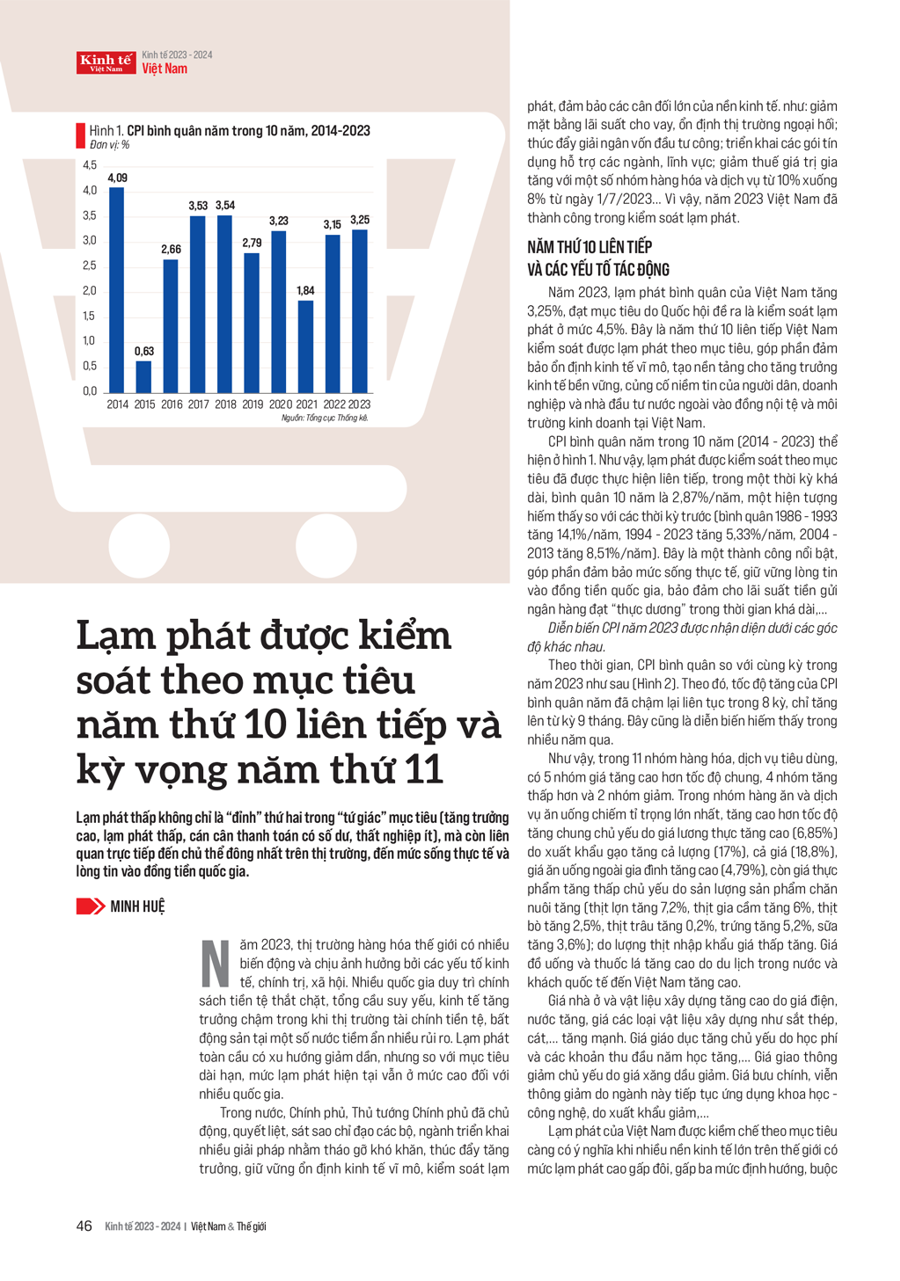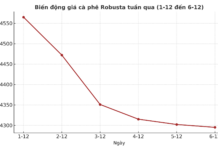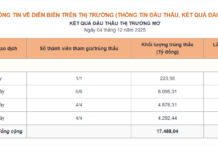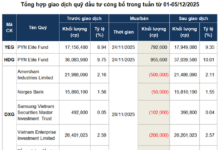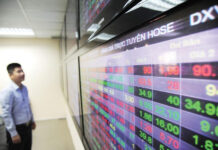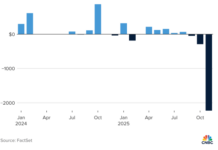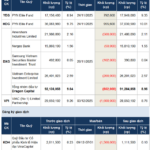The global commodities market experienced significant fluctuations in 2023, influenced by economic, political, and social factors. Many countries maintained tight monetary policies, leading to weak aggregate demand, slow economic growth, and financial markets and real estate sectors in some countries that posed potential risks. While global inflation showed a downward trend, it remained high for many countries compared to long-term targets.
Domestically, the government took proactive, aggressive, and meticulous measures to direct ministries and sectors to implement solutions to overcome difficulties, promote growth, maintain macroeconomic stability, control inflation, and ensure the major balances of the economy. These included reducing lending interest rates, stabilizing the foreign exchange market, promoting the disbursement of public investment capital, deploying credit packages to support industries and fields, and reducing value-added tax on some goods and services from 10% to 8% from July 1, 2023. As a result, Vietnam successfully controlled inflation in 2023.
THE 10TH CONSECUTIVE YEAR AND INFLUENCING FACTORS
In 2023, Vietnam’s average inflation rate increased by 3.25%, achieving the National Assembly’s target of keeping inflation at 4.5%. This marked the 10th consecutive year that Vietnam has successfully controlled inflation, contributing to macroeconomic stability, creating a foundation for sustainable economic growth, and strengthening the confidence of citizens, businesses, and foreign investors in the national currency and the business environment in Vietnam.
The average CPI over the past 10 years (2014–2023) is shown in Figure 1. Thus, inflation has been controlled according to the set target for a consecutive and prolonged period, with an average of 2.87%/year, a rare phenomenon compared to previous periods (average of 14.1%/year from 1986–1993, 5.33%/year from 1994–2023, and 8.51%/year from 2004–2013). This is a remarkable achievement, ensuring real living standards, maintaining trust in the national currency, and guaranteeing “positive” bank deposit interest rates for an extended period.
CPI movements in 2023 can be identified from different perspectives.
Over time, the average CPI compared to the same period in 2023 is as follows (Figure 2). Accordingly, the growth rate of the average CPI for the year slowed down continuously for 8 periods, only increasing from the 9th month. This is also a rare fluctuation in recent years.
Thus, out of 11 groups of consumer goods and services, 5 groups had higher price increases than the general rate, 4 groups had lower increases, and 2 groups decreased. The group of food and catering services, which has the largest proportion, saw a higher increase than the general rate, mainly due to the high increase in rice prices (6.85%) due to an increase in rice exports in both quantity (17%) and price (18.8%). The high increase in the price of eating out also contributed, while food prices increased slightly due to increased livestock production (pork increased by 7.2%, poultry by 6%, beef by 2.5%, buffalo by 0.2%, eggs by 5.2%, and milk by 3.6%). The low-priced imported meat also played a factor. Beverage and tobacco prices increased due to a rise in domestic tourism and international arrivals to Vietnam.
Housing and construction materials prices increased due to higher electricity, water, and construction material prices, such as iron, steel, and sand. Education prices increased mainly due to tuition and other fees at the beginning of the school year. Transport prices decreased mainly due to lower fuel prices. Postal and telecommunications prices decreased due to the continued application of science and technology and reduced exports.
Vietnam’s inflation control is even more significant as many large economies worldwide experienced inflation rates twice or thrice the target, forcing them to tighten monetary policies by continuously raising interest rates. In contrast, Vietnam initially shifted from tightening to loosening fiscal and monetary policies with various solutions, such as reducing budget deficits according to estimates, reducing or postponing various taxes and fees, increasing basic wages, reducing lending interest rates, and restructuring loans.
Inflation control was influenced by multiple factors.
First, the general factor is the relationship between supply and demand, between production and consumption (GDP) (Figure 4).
Accordingly, the growth rates of the two most significant components of domestic demand, asset accumulation and final consumption, were lower than the growth rate of domestic supply (GDP). Thus, domestic demand remained weak, causing inflation to slow down over the periods (as mentioned in Figure 2).
The government has advocated focusing on prioritizing growth. The boldness, flexibility, and agility in policies and administration have contributed to higher economic growth in the quarters, resulting in Vietnam’s annual growth ranking among the highest in the world while still controlling inflation according to the target.
The trade surplus in goods and services was mainly due to the increase in the trade surplus of goods compared to the previous year (USD 28,000 million compared to USD 12,140 million). Meanwhile, services incurred a deficit, but the deficit level significantly decreased compared to the previous year (USD 9,550 million compared to USD 12,624 million). The trade surplus contributed to the increase in domestic supply (GDP) when the two large domestic demand components were still weak. The large and increasing trade surplus was partly due to the positive trade ratio in goods (4.11%); a positive trade ratio benefits exports and disadvantages imports.
Second, an important factor in inflation is the impact of cost-push inflation in 2023, which had some notable developments (Figure 5).
While import prices increased significantly last year, creating a risk of “importing inflation” and forcing producers to “shield” consumers, this year saw a decrease. The reduction in import prices has contributed to the deeper decline in the prices of raw and auxiliary materials and fuels and power used for industrial production, particularly in the processing and manufacturing industry (-2.12%), leading to a decrease in industrial production prices (-0.88%) and processing and manufacturing production prices (0.55%).
This article was published in the special edition of Economics 2023-2024: Vietnam & The World, released on March 6, 2024. Please find the full article here: https://postenp.phaha.vn/chi-tiet-toa-soan/tap-chi-kinh-te-viet-nam
